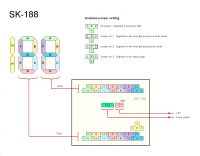Table of Contents
This is an old revision of the document!
Asus 486 System
I bought the motherboard in the late 2000's to use as a DOS gaming setup, but since moved most of that activity to Dosbox, and for hardware based Windows retro gaming, a suped-up Pentium IV.
Instead I kept the board around to host my various INMOS Transputer host cards, which really only work properly within DOS (there are various Linux drivers, but none [including my own] are really kept up to date).
In late 2020 I decided to rehouse the board in an old AT desktop case that I had stored for quite some time.
Hardware
Case
- AT desktop case
- 400W Corsair ATX power supply
- ATX to AT power cable adapter
- Repainted black from faded beige :)
Motherboard
- Asus PVI-486-SP3
- 3x PCI
- 1x ISA/VESA Local Bus
- 3x ISA
- 2x 72pin SIMM
- 2x IDE, 1x FDD, 2x Serial, 1x Parallel, 1x AT keyboard, 1x PS/2 mouse (header only)
- AMD 5×86 133MHz
- 64MB 50ns SIMM
- 512KB secondary cache
The keyboard controller chip (AMIKEY-2) was dead the last time I tried, so I had to desolder it and source a replacement.
Storage/IO
- Onboard PCI IDE controller
- Front panel mounted CF reader
- 3.5“ 1.44MB floppy drive
Video
- Voodoo 3 3000 PCI (16MB SGRAM)
Networking
- Intel EtherExpress Pro 100
- DOS Packet drivers e100b11b.zip e100b11c.zip
Other Cards
- Transtech TMB04 transputer TRAM carrier
- 1x INMOS T805 Transputer with FPU
- 16x 30pin SIMM slots (maximum capacity 16MB)
- 4x TRAM slots
- 37-way external D connector
- Transtech TMB08 transputer TRAM carrier
- 1x INMOS T225 Transputer
- 1x INMOS C004 programmable crossbar switch
- 10x TRAM slots
- 37-way external D connector
With those two TRAM carriers installed, that a maximum possible 15 Transputer processors (though I don't, as of November 2020, have enough Transputer TRAM modules to fit in all slots). With the other two ISA slots free, if I source another two TMB08 or INMOS B008 carriers, that's possibly another 20 Transputers, for a total of 35.
Case LCD Display
The case has an old-fashioned LCD 'speed' display. It reacts to the turbo button being pushed and displays one speed (or set of letters) in turbo mode, and another set in non-turbo mode.
The LCD display board is labelled as a SK-188, fortunately this is a relatively common board and a connection guide is available:



